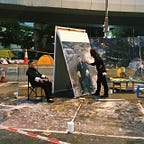Along the way, the sky started turning blue, and the buildings of the temple began to show. The sounds of birds and the cracking of the bamboo snapping in the wind filled the air.
Songwangsa (송광사) started in 867 a.d but has been rebuilt many times due to invasion and war. The temple is one of the “three jewels” of Buddhism in Korea and noted for producing some of Korea’s most celebrated monks.
When walking to breakfast, I needed to bow in front of the main building (Daeungbojeon) to ‘show respect’ the head of the temple told me. I am the only westerner here, and they have paired me with the head of the temple who only speaks a little bit of English.
The breakfast, lunch, and dinner are all the same and simple — rice or noodles, vegetables, seaweed, red pepper paste and some mushrooms. We then mix it in a bowl. The 15 monks sit on one side. I am on my own. There is enough time to wander before the morning meditations at 7 am.
The temple is on the side of a mountain (Mount Jogye) surrounded by pine trees. It is why the name of the monastery translates into the pine monastery. From the top of a narrow stone staircase, you can see the mountains and the sun rising through the valleys.
The public enters the compound through a bridge called Cheongryanggak. The bridge has a small pavilion where people can rest after a short hike up from the main road. The bridge has many beautiful paintings, signs and is a lovely resting place before entering. Before entering the temple, there are wooden monsters on each side of the path to scare away evil spirits.
The main entrance is under the drum tower (Chonggo-ru). It is the drums and bells that controls the time within the temple complex. The sound of the bell is for food. The banging of the drums, in a rhythmic fashion, is the call for chanting and meditation. It is the meditation which most come for to purify themselves from the outside world.
It is in the main temple hall where the meditation takes place. There are three golden Buddha’s. It starts with the ringing of a small bell. The sound dissipates through the chamber. The chanting begins, all in Korean. They gave me a little slip of English but quickly it is ignored. The chants are hypnotic. I close my eyes and let my mind focus on the sounds, the smells of the incense and the chanting. We sit cross-legged on mats on the floor but it is too hard for my knees and joints and soon sit on my side then with the legs out. The uncomfortableness brings me out of my state and leaves me frustrated when it shouldn’t. My mind wonders when it should be present.
The meditation ends, and I walk back to my sleeping area. The blankets piled on the floor to make my bed need to be packed up. The tea given is refreshing, and I have time to take a last walk around the campus. Like most temples in Korea, they try to separate the spiritual world and the material world using water, forests, and mountains. It is these things that help bring a sense of peace and calm.
Hiking down from the temple the trees are barren but there are buds. The delicate cherry blossoms are beginning to come out. The temperature is getting warmer with the rise of the sun. The nothingness has become something. The bells for lunch are ringing and is heard, but I am already down the mountain and waiting for the bus to go back to the city.
